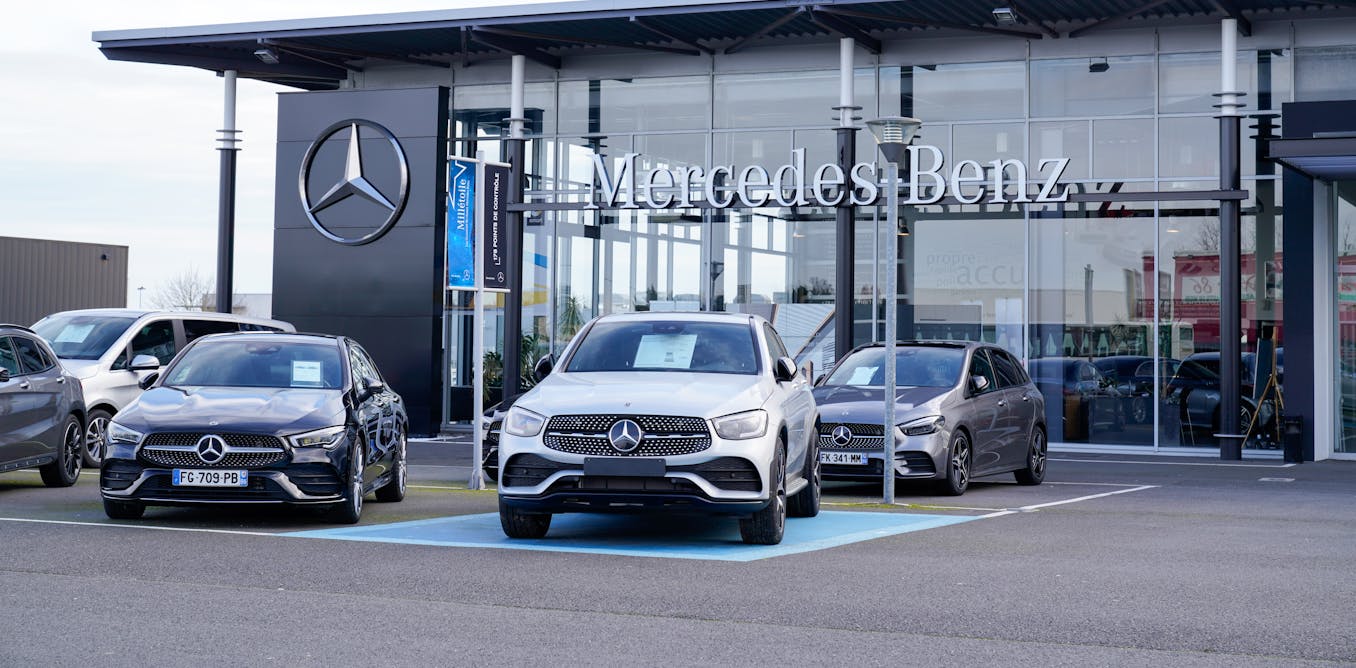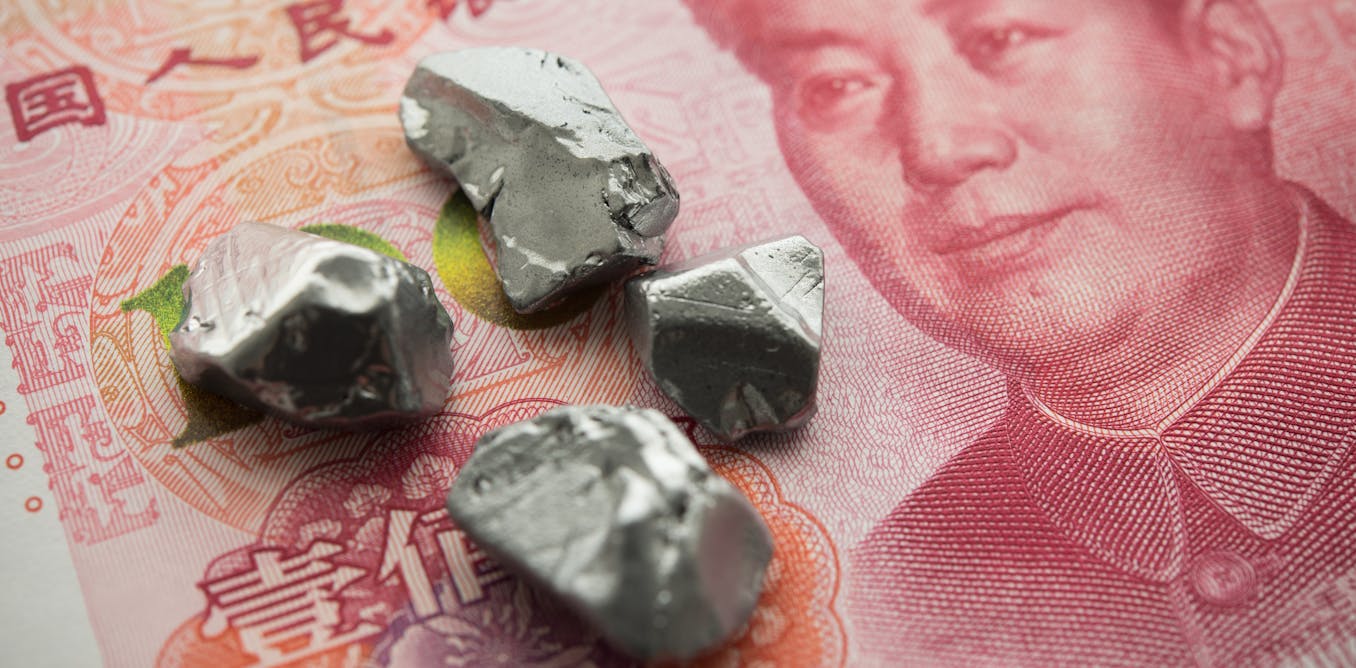Even before US president Donald Trump announced a 25% tariff on all imported cars, European automakers had been facing a multitude of challenges. Sales have slumped and manufacturers face rising costs, while Chinese rivals have rapidly been gaining market share.
The day before the tariffs announcement, the combined market capitalisation of Europe’s five major automakers (Volkswagen, Stellantis, Mercedes-Benz, BMW, and Renault) stood at around US$212 billion (£159 billion). This total is less than a quarter of the value of Tesla alone.
Yet the five European giants sell 25 million vehicles annually, accounting for a third of all cars purchased worldwide. Tesla, despite losing half of its market value since the beginning of the year, only just makes the top 15 automakers. It sells less than a third of what Stellantis alone delivers.
This essentially means that financial markets no longer believe that European carmakers can make money out of a business they have been dominating for almost a century.
The crisis does, in fact, stem from the obsolescence of the technology upon which the entire industrial model of the car was built.
The invention of German engineer Karl Benz, later made widely accessible to millions of consumers by American entrepreneur Henry Ford, was far more than just a product.
Cars enabled people to go anywhere whenever they wanted. This fuelled the last industrial revolution and one of the greatest leaps in human prosperity.
However, more than 100 years after the first assembly lines appeared in Detroit, the dream has stalled. In a world where economic and environmental resources are increasingly scarce, an entire industrial model looks unsustainable.
Why? Because it became inefficient.
A privately owned car is used for only 5% of its potential lifetime. It remains idle and occupying valuable parking space for the other 95%. It carries an average of just 1.2 passengers, utilising only a quarter of its capacity.
If an alien were to observe human civilisation, it might conclude that humans have lost that special ability that made them so different from all other species: to do more with less.
Additionally, around 80% of cars are still powered by fossil fuels that cost significantly more than electricity per mile. This is despite economies of scale that are bringing down the price of purchasing a plug-in electric vehicle (EV).
These issues have hit the European – and also the US – automotive industries hard. These regions were the birthplace of the industry itself. For CEOs and policymakers, who often belong to a generation (and a gender) steeped in traditional automotive culture, finding solutions has proven difficult. However, there could be a clear path forward.
Here are three ideas to bring the European automotive industry in the 21st century.
1. Become more competitive by attracting EV rivals
China has already secured a technological advantage in this field – similar to the dominance once held by Volkswagen when it first established factories in Shanghai.
In the same week when BYD announced that it has surpassed Tesla in terms of revenues of electric cars, the Chinese automaker also revealed that it had developed a system to charge an electric car with 400km (249 miles) of range in five minutes.
BYD and other Chinese manufacturers export less than 10% of their products to the EU. They will survive any import duty that the EU imposes on them. Instead of fearing Chinese automakers, the EU should entice them to establish production facilities in the bloc, encouraging competition and innovation within its borders.
2. Sell services and symbols
New business models should focus on selling services as well as objects. This trend is prevailing in many industries, and carmakers should embrace it to develop partnerships with organisations that can make driving a less wasteful experience. Autonomous driving technology, for example, offers the chance to take vehicle-sharing to a much wider customer base.
And European automakers should trade on their history as a symbol of expertise and longevity. This is not so different to what camera-maker Kodak has done to survive to the digital revolution. It is notable that Ferrari is now worth more than its bigger sister company Stellantis.
3. Governments must get involved
For the transformation to succeed, governments must play a role. It is not about propping up the European industry with subsidies or treating cars as the new steel industry. Rather, it is about designing and implementing the infrastructure that the future of mobility requires.
Dan74/Shutterstock
A century ago, European cities were completely restructured to transition from horse-drawn carriages to the first Fiat Topolinos rolling out of the Mirafiori factory.
Today, we need new charging networks and dedicated lanes for electric and autonomous vehicles. This is already happening in China clearly showing that without a significant modernisation of infrastructure innovation does not happen.
The impact of tariffs
Trump’s tariffs will hurt – badly. Volkswagen, which exports two thirds of its production outside western Europe, will suffer most after assuming that its “people’s cars” could be sold indiscriminately to different populations.
However, the era of tariffs should serve as a wake-up call rather than a death sentence. The European automotive sector must use this challenge to reinvent itself, just as it did in the post-war era.
In the 1960s, countries like Italy and France combined industrial strategy of the likes of Fiat and Renault with a vision of the future. This alignment of industrial ambition and pragmatic policymaking was a key part of post-war reconstruction.
Now European leaders must embrace the same spirit of bold, forward-thinking innovation to build a transport system that is capable of setting global standards. The automotive crisis is not just an industry-specific issue. It demands a revival of both vision and pragmatism.

The post “Three strategies to help European carmakers regain their edge” by Francesco Grillo, Academic Fellow, Department of Social and Political Sciences, Bocconi University was published on 05/02/2025 by theconversation.com



































Leave a Reply